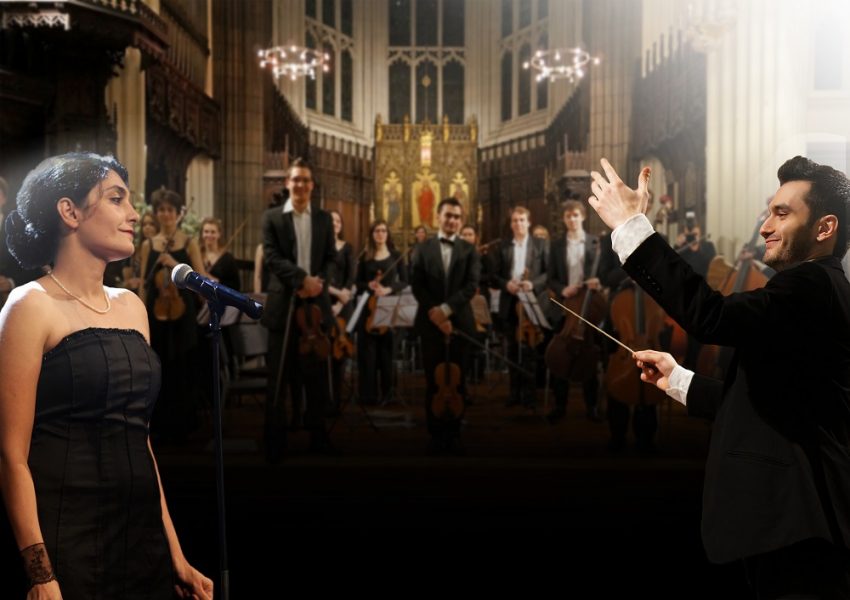Edinburgh’s festival reputation might centre on the summer marathons of the Fringe and the International Festival, but increasingly it is becoming worthwhile to keep an eye on the smaller programmes. The Edinburgh Iranian Festival is a great example of a festival vehicle that has grown from strength to strength since its first appearance in 2009. Driven at heart by a cadre of dedicated volunteers and the Iranian ex-pat community, the festival’s aim of promoting Iranian culture during a time of political pressure is simple and persuasive.
Promoted by the Edinburgh Iranian Festival as a “unique and one-off collaboration”, a highlight of this year’s programme is the evening Classical Concert staged at the Assembly Hall. Featuring the debut Scottish performance of the vocalist Darya Dadvar, the renowned Iranian-born singer formally trained in Toulouse, along with the virtuosic conductor, composer and violinist Amin Keshmiri, the concert certainly delivers on this promise by bringing together two of the most innovative Iranian artists performing today. Moving between the scales of humour and sincerity, the broad brush of history and the intimacy of human understanding, the concert conjures all that is best about classical music and the cultural exchange it can enable.
In an impressive feat of multi-tasking, Glasgow-based Amin Keshmiri conducts an ensemble of string and woodwind colleagues from the Royal Conservatoire of Scotland, narrates the musical journey and personally performs a number of additional pieces himself. The aim of the concert, Keshmiri explained, is to celebrate both western and eastern music, to pay tribute to the universality of musical inspiration and acknowledge the broad diversity of the audience and sponsors who have made the festival possible.
Rather unexpectedly, therefore, the concert opens with an invigorating rendition of Mozart’s Eine Kleine Nachtmusik. It is a canny piece of music to open proceedings, being one of those few instantly recognisable and infuriatingly unnameable western classical compositions that have permeated deeply into the popular consciousness. Or perhaps that should be the western popular consciousness? Perhaps more than a few audience members reflect on the habit of hearing without listening; and the musical assumptions we can fall into as a result of this habit when given rein. For example, seeing classical music as something intrinsically “western” and thereby approaching different classical genres with the monolithic categorisation of “world music”. Or the even more terminal assumption of seeing classical music, whatever its origin, as “old music” with no relevance for the complicated times we live in.
Though there are several interludes of western music to follow, including Darya Dadvar’s charismatic rendition of L’armour est un oiseau rebelle from Carmen, the most touching moments came with the Iranian and Middle Eastern compositions. Keshmiri showcases both his own prodigious skill with the violin as well as the full, dramatic urgency of the violin as an instrument, leading the orchestra through his Shooshtari for violin and orchestra arrangement. A brief narrative regarding the founding of his Arezoo Symphony Orchestra in memory of his sister, followed by a recollection of being a young boy in Iran obsessed with snatches of the source music, contextualise the piece still further.
Darya Dadvar’s performances are absorbing and seemingly effortless, switching smoothly between European languages and the various native languages of Iran. The most memorable moment comes with a soaring a capella performance of Sarzamin e man, a song derived from the Dari Persian language. Ms. Dadvar movingly dedicates one song to Syria and particularly to Syrian women.
The levels of skill and dedication embodied in the performances of Dadvar and Keshmiri make the concert fantastic to watch, but it is really the humour and character that make it unforgettable. For one thing, through both accident and design, the concert fondly explores the sheer messiness of history. When singing the song considered by many to be the first national anthem of Iran, this is accompanied by light-hearted confessions that the song was in fact first composed by a Frenchman. Similarly, upon being presented with scarves woven of the world peace tartan, the performers were told that this tartan had first been produced by an Edinburgh-based Iranian tailor.
The concert also demonstrates that, far from being the music of a lost era, classical music is today very much alive, pushing new boundaries and forging new, unexpected bridges of cultural understanding. The clear message is that classical music, from wherever it originates, not only belongs to the future, but could have an important role in defining it.
